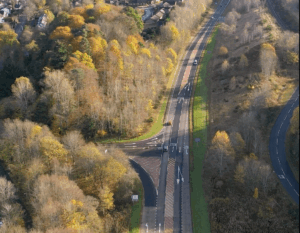Accelerating economic recovery and laying the groundwork for an inclusive, greener transport network will be at the heart of future transport investment in Scotland, according to Transport Scotland.
This will be kick-started by the second Strategic Transport Projects Review (STPR2) will help to deliver the vision, priorities and outcomes for transport set out in the National Transport Strategy (NTS2). Phase One has been published which, together with conclusion of Phase Two in autumn this year, will set out Scottish Government’s investment priorities for the next 20 years.
Phase One recommendations for national investment priorities in the short-term include; supporting smart and sustainable travel across Scotland, with development of active freeways and expansion of 20mph zones, improving public transport, with reallocation of road space for buses and improved accessibility at train stations, supporting the transition to low carbon transport, with investment in alternative fuels and progression of decarbonisation of rail and enabling larger loads to be carried by our railway network, encouraging freight to shift from road to rail transport.
Other recommendations include the rationale for investment in Glasgow Metro – a new mass transit system of Scotland’s largest urban area, improved resilience of the trunk road network at the A83 Rest and Be Thankful.
These priorities underpin the 2021-22 Draft Budget set out last week, which commits to deliver a clean, efficient, and connected transport network with investment of £3.2 billion; including £1.6 billion for rail and bus services and £100.5 million for active travel.
Cabinet Secretary for Transport, Infrastructure and Connectivity, Michael Matheson said: “As we continue to navigate our way through an unprecedented global health emergency, the investment decisions we make have never been so important. We want to lock in the changes to the healthy, green travel options we’ve seen during the pandemic, while supporting interventions that will aid and help accelerate economic recovery.
“We are conducting a thorough, evidence-based review of the performance of Scotland’s strategic transport network across active travel, bus, ferry, rail and the trunk road network and my thanks go to everyone who is engaged in that process, particularly our Regional Transport Working Groups.
“Phase One sets out some of our transport investment priorities for the next few years, which will support a fair and sustainable economic recovery from the pandemic, while working towards our longer term goals of making Scotland more accessible for residents, visitors and businesses; improving connectivity and highlighting the vital contribution that transport investment can play in enabling and sustaining Scotland’s economic growth.
“STPR2 will help us to deliver the vision, priorities and outcomes set out in our National Transport Strategy as well as aligning with other important national plans such as the Climate Change Plan, Infrastructure Investment Plan and National Planning Framework.”
Leader of Glasgow City Council, Susan Aitken said: “The success of Glasgow and its surrounding region is absolutely fundamental to the Scottish economy. This report not only makes clear the pressing economic, environmental and social case for a much better-connected city and region, it also shows the potential of the Metro project to deliver that transformation.
“Those were also key findings of the expert and independent Connectivity Commission that I tasked with taking a fresh look at Glasgow’s transport and travel challenges – and which first proposed a Metro project. I’m very pleased that STPR2 builds so strongly on that work.”
John Lauder, Deputy CEO of Sustrans and Executive Director for Scotland said:“Sustrans Scotland welcomes the recognition of the importance of active travel in STPR2. The continued commitment of £100m annually for the next 5 years provides continuity to build on well-established partnership programmes with local authorities and other statutory bodies to enable sustained planning of high quality infrastructure.
“The evidence and expertise to make Scotland’s transport greener, healthier and fairer is all there. The time to act is now.”
As a result of the COVID-19 pandemic, STPR2 will now take a two phased approach, with Phase One recommending progress on priority transport projects in the short-term – two to three years – while Phase Two will complete the STPR2 process, focusing on the delivery of medium to longer-term schemes over the next two decades.
Phase Two will be concluded later in 2021. Tansport Scotland has also published an update on the work to develop a 20-year investment plan for transport, including the transport options which will be appraised in detail this year.






















